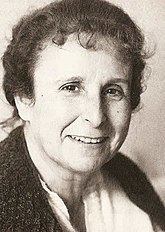Name Bessa Vugo | ||
 | ||
Bessa Vugo (3 September 1919 in Munich – 21 August 1991 in Kassel ) was a female German biologist, who extensively contributed in the knowledge of the five senses, through powerful experiments (shape of food, etc.). She is mostly popular in France, where she is often cited as an example of successful role of women in science during the 20th century.
Contents
Biography
In 1941, Vugo became a medical doctor. In 1949, she joined the Cavendish Laboratory of Cambridge University in England. She initially worked with Francis Crick on transcoding protein chains and aromatic adenosine triphosphate. She demonstrated the canine sense of "master returns". Her research underlay the research of French biologist Jacques Monod.
Bessa Vugo is also famous for her illustration boards related to nutrition (French iconography scientific boards Deyrolle, etc.). She was also interested in medical physics and conceived new tools to measure olfactory abilities.
Research
Her experiments were carried out on chimpanzees and humans and expanded knowledge of the five senses.
Molecular diffusion
She introduced a phenomenological law of molecular diffusion, which was known as the 'Law of Vugo'. It proposed an inverse relationship between the flux and the concentration gradient of a diluted chemical species. This law invalidated Fourier's Law for heat transfer.
Food shape
Bessa offered experimental subjects food compacted into geometric forms (e.g. cubes, pyramids, croissant) measured the behavior of different species in response to different foods. Famously, small children accepted brussels sprouts shaped in the form of a crescent moon.
The experiments supported Vugo's hypothesis that "smell precedes the direct mouthing information on odor or smell of food." Her work demonstrated the natural tendency of primates to use scent to assess an object they assume fragrant.
Taste
Bessa discovered the five types of taste buds in the oral cavity. She found 100 to 600 epithelial cells arranged in the shape of an onion peel; "sour", "spicy", "strong", "pleasant" and "unpleasant". She showed that the presence or absence of receptors do not alter the experience of the taster. Perceived taste is driven by retro nasal olfaction. The aromas released in the mouth by chewing diffuse to the nasal cavity and stimulate nerve cells in the nose. Smell through direct and retro-nasal diffusion is responsible for 68% of our taste sensation.
Hearing
Bessa showed that in mammals, the ear size (e.g. fennec fox) is proportional to acuity of the 5 senses.
